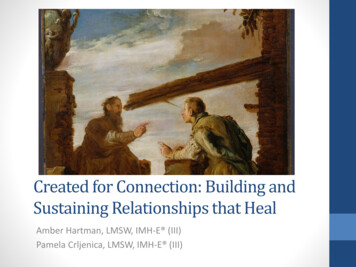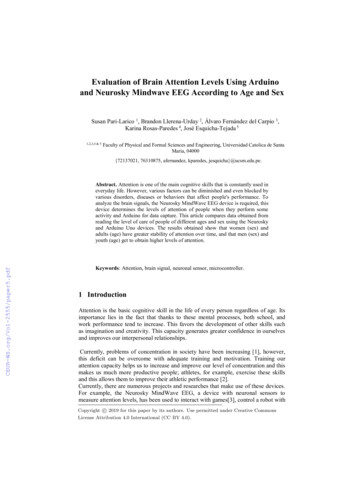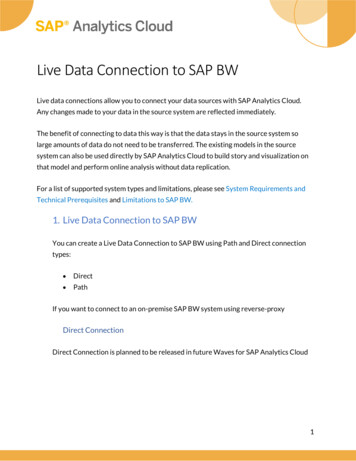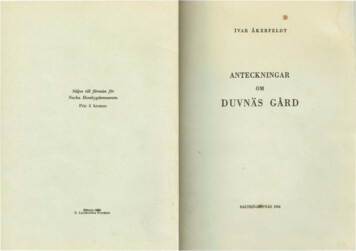
Transcription
Created for Connection: Building andSustaining Relationships that HealAmber Hartman, LMSW, IMH-E (III)Pamela Crljenica, LMSW, IMH-E (III)
Introductions Amber Hartman, LMSW, IMH-E (III)Work:Infant Mental Health 15 years:7 years homebased, out-patient,Sienna Heights University Adjunct4 years, supervised PAT program,reflective supervision, privatepractice, EMDR trainedPersonal:Mom of three, Yooper transplant,ACEs 8/10*, converted toCatholicism in 2016, passionateabout spirituality in practice andreflective supervision
Introductions Pamela Crljenica, LMSW, IMH-E (III)Work:Homebased family therapy 13years, IMH last 8 years, facultyat Michigan State University for6 years, private practice andconsultation, EMDR trainedPersonal:Mom of two, married to a warrefugee/immigrant, ACEs 0,passionate about work withclinicians
Many thanks to Katie O’Shea, co-creator of the EMDR Early TraumaProtocol “When There Are No Words” Bonnie Badenoch, expert on InterpersonalNeurobiology (IPNB) and author of Healing the Heart ofTrauma Jim Knipe, EMDR therapist and author of EMDRToolbox: Theory and Treatment of Complex PTSD andDissociation Our clients and supervisees, especially those thatallowed us to share their stories with you today
Foundational Principles1) We are created for connection. We are hard-wired toattach and bond our whole lives; inclusive of both infantattachment and adult love.2) We will use whatever strategies (even problematic ones)we can to remain connected with our “person”.3) Trauma is the bad things that happen AND the goodthings that don’t.4) Healing occurs in the context of connected, supportiverelationships. Painful events that are not seen and heldby another don’t have the relational support tointegrate. In other words, who was with you before,during, and after the trauma?5) One way to support this innate drive to connect is bydeveloping and sustaining reflective capacity.
Format of this Workshop: Created for Connection: Building and Sustaining Relationships ThatHeal Title refers to both the relationships with clients and moreimportantly the relationships we have with our “selves.” Our systems were created with an innate capacity to heal. Process oriented We will conduct the workshop in much the same manner as youwould conduct a session using these techniques. We want you to experience calming your left hemisphere in order toconnect right to right with us and parts of yourself the parallelprocess. Experiential It a requirement that all EMDR therapists personally experienceEMDR. Shouldn’t all therapists be required to do their own work? You will have an opportunity to experience each of the strategiespresented both for professional learning and personal growth.
Workshop Outline1)2)Experiential Exercise #1- ContainerLecturea)b)c)3)Case Examplesa)b)c)4)5)6)Adaptive Information Processing ModelWindow of ToleranceInner CommunityReflective supervision “Babette”Reflective supervision “Katie”Infant Mental Health client “Mom”Experiential Exercise #2- What’s the Part of You Look Like ?Questions and ConclusionContainment
Experiential Exercise #1:Container
Preparation for Container You have a sample script on the next slides and in yourmaterials. We will:1) Demonstrate Container with a volunteer2) Review the sample script and tips for this exercise3) Guide everyone in practicing Container We’re telling you this in advance because we know that oursystems are meant to focus on one thing at a time, and wewant you to be able to give each of these experiences yourfull attention.Adapted from the work of Katie O’Shea
Sample Script for Container“We all have things that have happened to us and stuff thatmay come up from time to time, so we need to have a way toset that stuff aside until we can give it our full attention. Oursystems are made to be able to do this, with our righthemispheres storing experiences until we can give them our fullattention and learn (or unlearn) all that we need to. This will bewhat happens during our time together we’ll take stuff out bitby bit so you can learn (or unlearn) from it, and we’ll do ittogether. Until then, you need a place where you can store thisstuff, and you can help your right hemisphere by picturing aplace or container to set that stuff aside for now. What comesto mind as a place where anything that needs to be reviewedcan be stored until you can give it your full attention? It can bea picture in your mind or you can leave it here with me in mybox.”Adapted from the work of Katie O’Shea
Sample Script for ContainerIf client pictures something, ask what to call it this is their cueword. Or, they may select your container.“Now, just focus on your cue word/my container and leteverything that needs to be reviewed from the past, thepresent, and the future be set aside for now. Let me knowwhen it’s all in, or if you’re having any trouble.”Ask client to practice containing until your next appointment,perhaps at times of transition such as waking up in the morningor going from work to home. Let them know that their brain ismade to do this and the more they practice the easier it will getto do this, even with very distressing content. Acknowledgethat their container may change or develop over time and thatthis is totally fine.Adapted from the work of Katie O’Shea
Tips for Container Should NOT be something that you see in day to day life asthis may be activating. Should have a way to keep material inside (i.e., a lock or a“time stamp” until next session). Container can develop or change as you practice you mayrealize that you need something different, bigger, orstronger. Feelings do NOT go in the container, but “whatever thefeelings are about” can. Parts of self do NOT go in the container this requires a SafePlace. Should feel like looking at the material easily and effortlesslyand/or a felt-sense vs. itemizing. If it’s difficult to set something aside, it might just mean it’sready to be cleared and that you need support andconnection.Adapted from the work of Katie O’Shea
“It is more important for meto trust my people than it isfor them to trust me.”- Bonnie BadenochHealing The Heartof Trauma, pg. 38Image courtesy of Bonnie Badenoch
EMDR Adaptive InformationProcessing (AIP) Model “The natural tendency of the brain’s information processingsystem to move to toward a state of mental health.”- Shapiro, 2018 This work requires the same level of embodied trust in thisprocess as exists for the trust in the body’s ability to heal fromprimarily physical injury. Examples : cut finger, passing by a fatal car accident Infant Mental Health perspective adds the critical role ofattachment in this process, i.e., healing occurs in the contextof connected relationships.
Window of Tolerance
Joined Window of Tolerance
Inner Community EMDR “Language of Ovals” theory of personalitystructure identifies all parts of an individual’s personalityas adaptive, functional, protective, and designed tomaintain relationships. (Knipe, 2015) “It is quite a gift that our inner world includes the othersin the memory so there can be inner resolution,especially when no outer reconciliation is possible. This isthe essence of inner community work.” (Badenoch, 2018)Basic principle:Just be with whoever is in the room.
Inner Community ManagerAdapted from the work of Bonnie Badenoch and Jim Knipe
Inner Community Wounded PartsAdapted from the work of Bonnie Badenoch and Jim Knipe
Inner Community ProtectorsAdapted from the work of Bonnie Badenoch and Jim Knipe
Inner Community “True Self”Adapted from the work of Bonnie Badenoch and Jim Knipe
Inner Community and IMHAdapted from the work of Bonnie Badenoch and Jim Knipe
Inner Community
Inner Community
Reflective Supervision CaseExample 1: Babette Wonderful employee woefully behind on paperwork Worked to identify the part struggling in reflectivesupervision Once part was identified, employee was able to catch upon all paperwork before the end of following week Addendum: New job, same part needing to behealed demonstrates the importance of continuedtreatment
Reflective SupervisionExample 2: Katie Working with a very difficult case, many recent challenges Reflective supervision begins with much “idle chatter”,transitions to the “real issue”:“I think it’s time to stop seeing the kids with dad.” Identified and cared for the part that was struggling. Comfortable and confident she could continue work withchildren at father’s home with increased sense of empathy. Addendum: This has continued to be the case for manymonths after.
Infant Mental HealthCase Example Mom with trauma history, death of both parents, brokenmarriage, difficulty parenting her children due to distress. 2.5 years in, distress due to lack of phone call fromhusband. Identified and cared for 5 year old part: “I just talked toher.” Able to continue parenting her children. Addendum: Very intense processing, co-worker in officebuilding activated and distressed by what she could hear.
“Our job is to keep ourhearts open in hell.”- Steve LevinBloody Saturday - a crying Chinese baby amid the bombed-out ruins of Shanghai's South Railway Station, 1937
Experiential Exercise #2“What’s The Part of You Look Like.?”Image courtesy of Bonnie Badenoch
Preparation for “What’s The Part ofYou Look Like ?” You have a sample script on the next slides and in yourmaterials. Please know that we will contain whatever comes up atthe end. We invite you get comfortable in your chair, close youreyes, and take a few deep breaths. Bring to mind a recent time that you were strugglingwith your work though we trust that your system willbring forward whatever part of you needs help righthere today, and it may not have to do with work; justknow that all parts of you are welcome here.Adapted from the work of Katie O’Shea
Sample Script for “What’s The Partof You Look Like ?”“What does the part of you look like that was struggling withthat? Don’t try, but just notice, easily and effortlessly, whatevercomes up. Now, sit with whatever you’re noticing for amoment. Just notice what you notice and know that it’s whereyou’re at right now and that’s ok. Now, you might deepen theexperience by noticing what emotions arise in you as you sitwith this today. Perhaps you feel something in your body. If so,you may put a hand there and just notice. Can you movetowards compassion for that part of yourself? This isn’t alwayseasy. Just notice whatever answer comes. Whatever answeryou get, take a moment to sit with this idea of compassion forall parts of yourself, especially parts of you that may struggle attimes in this difficult work that you do. Can you thank that partfor coming forward today?”Adapted from the work of Katie O’Shea
Sample Script for “What’s The Partof You Look Like ?”“As we move to ground ourselves back to the presentmoment, we invite you to take a few deep breaths.Slowly invite movement back into your body, noticingany areas of stress or tension in your body and taking amoment with those areas. We invite you to slowly openyour eyes and notice where you are at right here, rightnow, in the present moment. When you are ready,return the room.”Tip:Considering what this part may need for repair andhealing in order to move forward is an area for furtherexploration.Adapted from the work of Katie O’Shea
Questions?
Evaluations and Follow-up Objectives 1. Integrate EMDR concepts regarding personality structure withthe Infant Mental Health concept of reflective capacity. (InnerCommunity) 2. Learn and apply the EMDR "Container" technique inrelationship-based Infant Mental Health practice. Interest and Recommendations This is our first time presenting this material-was it what youneeded? Is there interest in a longer session to dive deeper?
4) Healing occurs in the context of connected, supportive relationships. Painful events that are not seen and held by another don't have the relational support to integrate. In other words, who was with you before, during, and after the trauma? 5) One way to support this innate drive to connect is by developing and sustaining reflective capacity.











